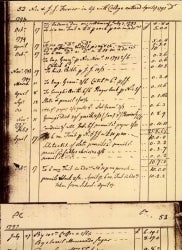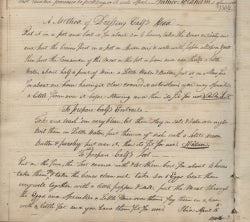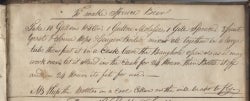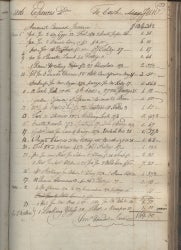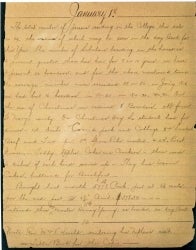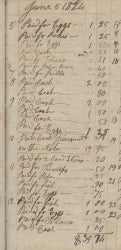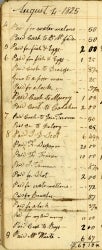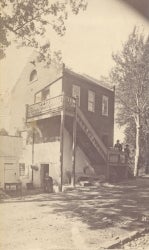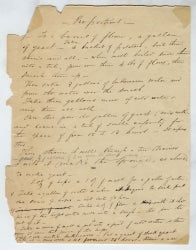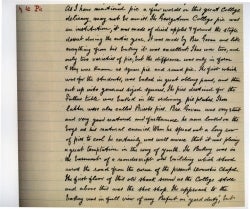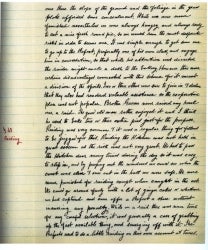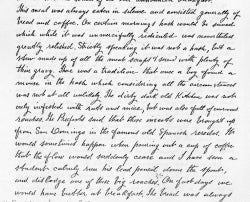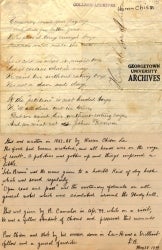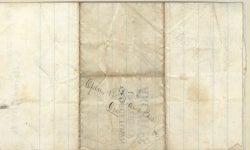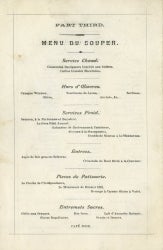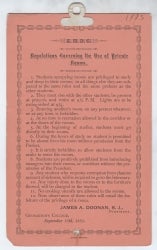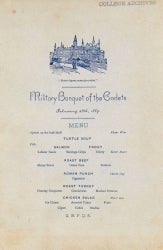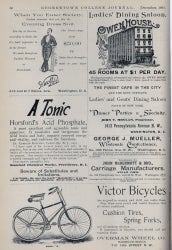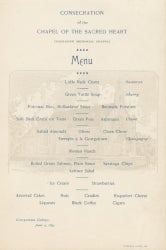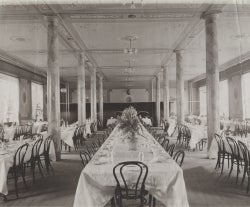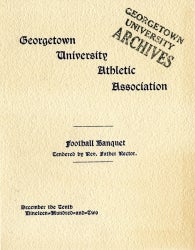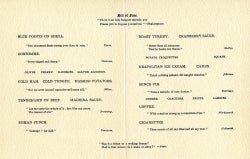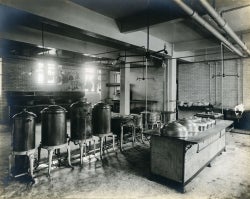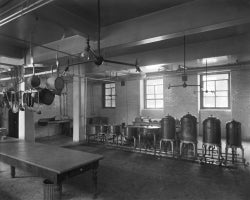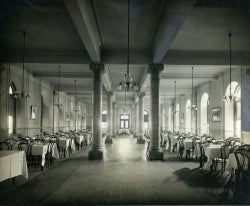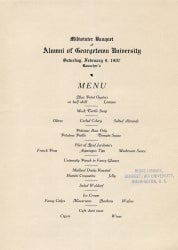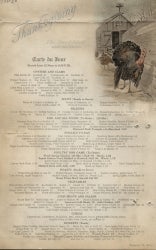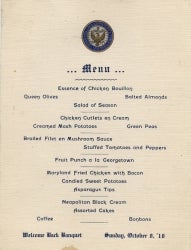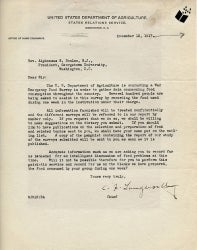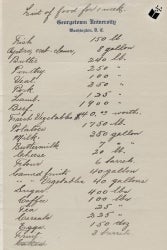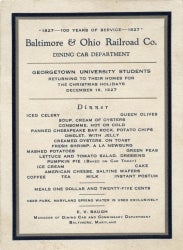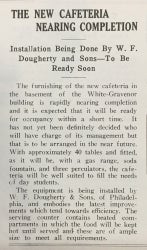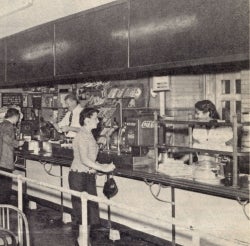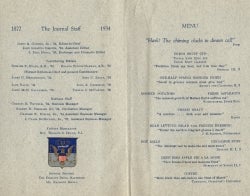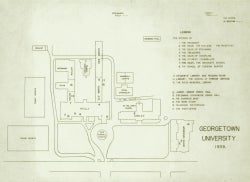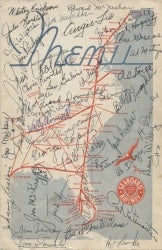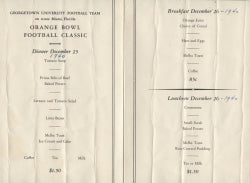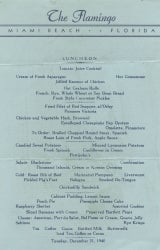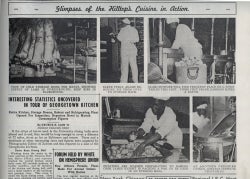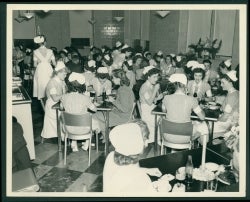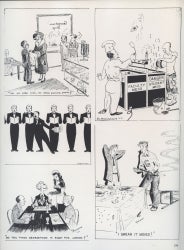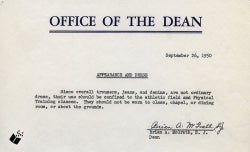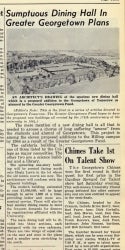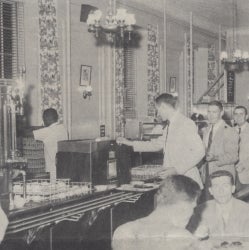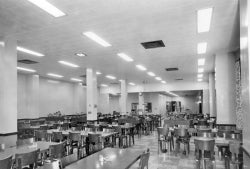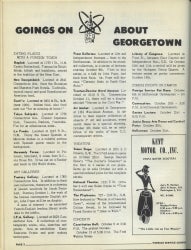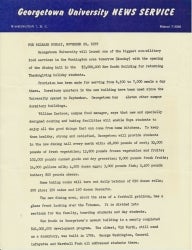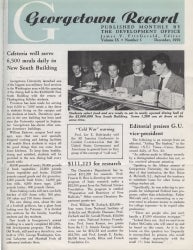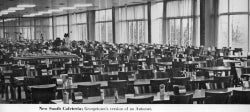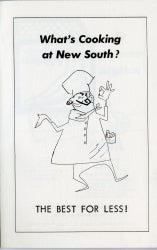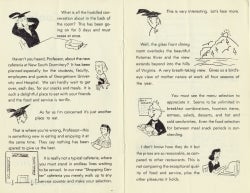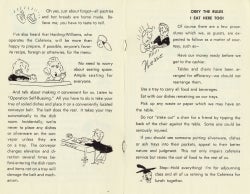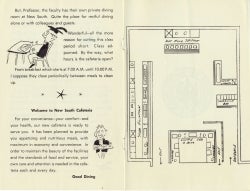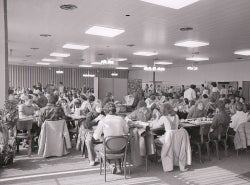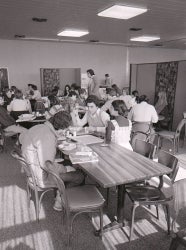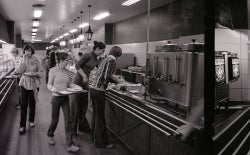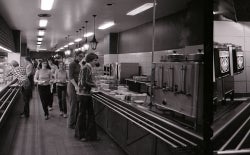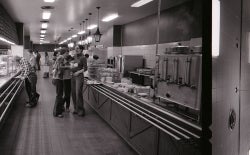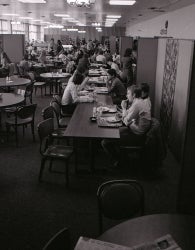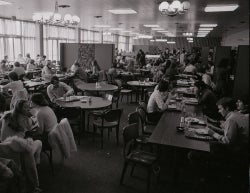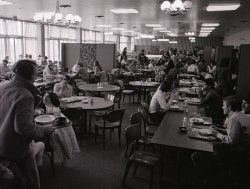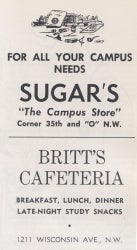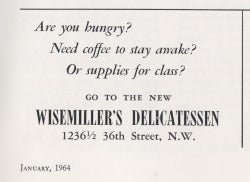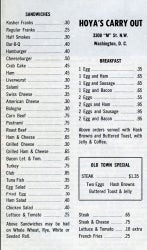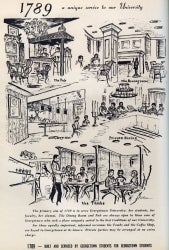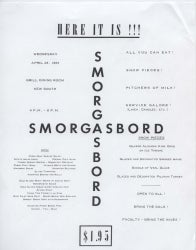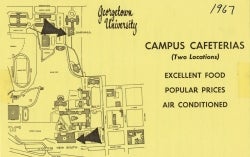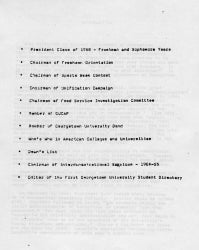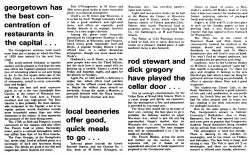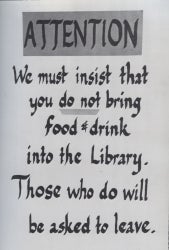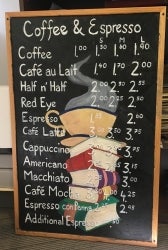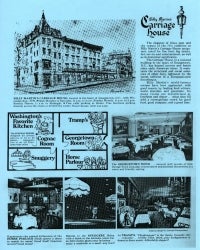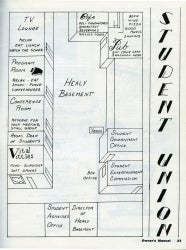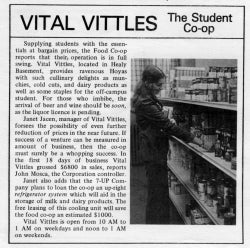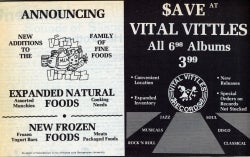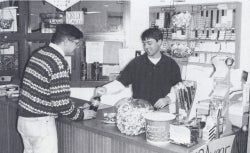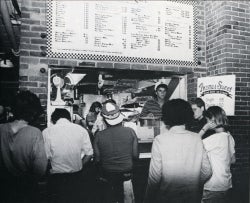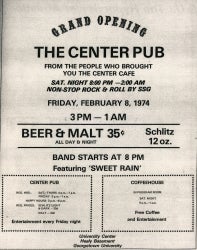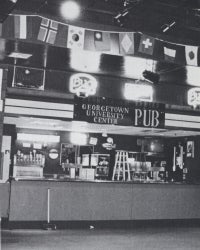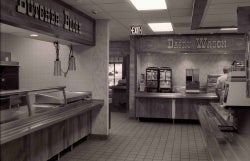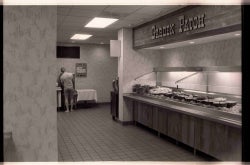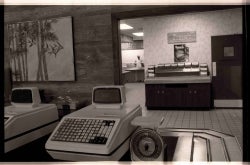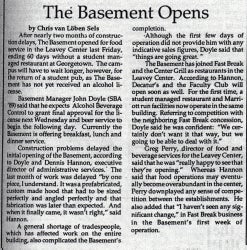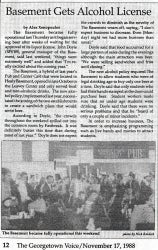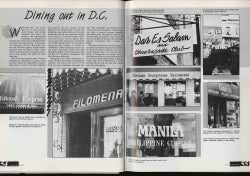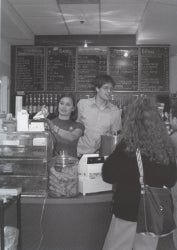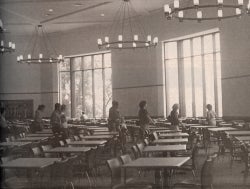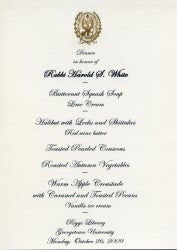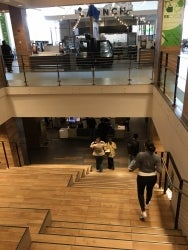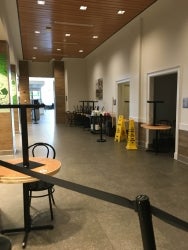This exhibition uses records in the University Archives to highlight eating experiences on campus going back to the 1790s. Included are examples of financial records showing what kinds and quantities of foodstuffs were purchased or otherwise acquired, menus revealing what dishes were served on formal occasions, student descriptions of (not always well-received) meals, and photographs of dining rooms showing where meals were eaten. And once students had greater freedom to leave campus in the 20th century, their off-campus dining preferences are documented through advertisements and descriptions in student publications such as The Hoya, the yearbooks and the Foreign Service Courier.
Tuition credit in exchange for coffee and sugar. In the financial accounts for Georgetown’s first international students, 1793-1795 (Ledger A 2)
Georgetown’s tuition and board in the 1790s (as now) was relatively high. As a result, it was not unusual for students to use barter to pay some of what they owed. In the case of Nicholas and Jean Jaques Fevrier who came to Georgetown from the West Indies, partial payment was received in the form of coffee and muscovado sugar. This is seen on the second page of their accounts. The coffee and sugar would have been used on campus or sold/exchanged for other needed goods.
Recipes for calf. In the House expenses ledger, 1801-1808 (Ledger I.A.3.b)
It is common in the early University account ledgers to see entries unrelated to money. Paper was expensive and, as a result, there was a tendency to reuse the ledgers or at a minimum to fill up some of the unused portions. An example of this is the 1801-1808 expenses ledger which includes a number of recipes relating to cooking with beef, including A Method of Dressing Calf’s Head, To prepare Calf’s Entrails, and To prepare Calf’s Feet.
Recipe for spruce beer and list of foodstuffs bought for campus in June 1806. In the House expenses ledger, 1801-1808 (Ledger I.A.3.b)
Another recipe, for spruce beer, is inserted later in the book which contains the calf recipes (see above). Perhaps the inclusion of the entry 1 Gallon Essence of Spruce to make Beer (at a cost of 50 cents) in June 1806 motivated the bookkeeper to ensure the recipe was recorded. The June 1806 entries provide other glimpses into the diet on campus, through the recorded purchases of foodstuffs such as eggs, fish, corn, lamb, chocolate, cherries, veal, oats, and cucumbers.
A blog post on the spruce beer recipe can be read here.
Christmas day menu at Georgetown College, 1812. In Father John McElroy, S.J.’s diary, January 1, 1813
On Christmas day the Students had for dinner -1st dish, Corn'd pork and Cabbage; 2nd Smoked Beef and Turnips. 3rd Spare Ribs roasted & 4th Roast Goose. -Toddy. Apples. Cakes and Crackers. there were 6 dishes of each kind served up. They had warm Cakes, buttered for breakfast
Fr. John McElroy managed Georgetown's financial affairs. He was an inveterate diary keeper and his writings tell us much about campus life in the early 1800s.
Given the difficulties with travel, it was the custom at this time for all but the local students to stay on campus for most of the year, hence the holding of a Christmas dinner for them on campus.
College expenses, including foodstuffs, June 5, 1824. In List of Expenses, April 21, 1817-December 31, 1826 (Ledger I.A.3.d)
College expenses, including foodstuffs, August 4-9, 1825. In List of Expenses, April 21, 181 -December 31, 1826 (Ledger I.A.3.d)
"No one will ever be permitted to dine out of the College . . . " From Regulations for the Students of Georgetown College, 1829
13. No one will ever be permitted to dine out of the College except with his parents, and that not oftener than once a month, and a note must be previously sent by the parents requesting this permission - before he can get his clothes he must ask a note of the Prefect, to whom he must on his return (which must always be before 5 o’clock) report himself.
Students who boarded on campus were not able to vary the campus diet by eating off campus. According to these 1829 regulations, even students whose parents lived locally were only able to dine at home once a month.
Brother Thomas Gavan, S.J., seated to the left of the College bake house and store, ca. 1889
From about 1856 until 1895, Brother Gavan was the Georgetown College baker. Francis Barnum, S.J., who was a student in the 1860s and returned to campus in 1898 as Riggs Librarian, recalled in memoirs of his student days that Brother Gavan’s bread (which was the major component of breakfast and supper on campus) was unexcelled. During his time the reputation of Georgetown bread extended over the entire province [of Maryland]."
The College bake house was housed in the basement of a building that stood near the southwest corner of Dahlgren Chapel from 1814 until 1908. The College store and the shoemaking shop were housed above it.
Brother Thomas Gavan, S.J.’s bread recipe
-Proportions-
-To a barrel of flour, a gallon of yeast. Take a bucket of potatoes, boil them skins and all, -when well boiled turn them into a tub, pour over them 4 lbs of flour; then smash them up-
Then take 3 gallons of lukewarm water and pour the water over the smash.
Take three gallons more of cold water & mix them all well.
Over this pour the gallon of yeast; mix well ; and leave in a tub of double capacity for the space of from 12 to 13 hours.- It ripens thus.
Then strain it well through a tin strainer
-pour 2 gallons of 1. w. [lukewarm water] over the skins -mix
& with it make the sponge, as above.
-To make yeast-
1 oz of hops & 1 oz of malt for a gallon of water.
1) Take a gallon of water & when it begins to boil put one ounce of hops - Let boil ½ hr -
2) Take 4 oz of flour & mix with it the juice of the hops until made into a dough - then pour the rest of it -
3) Take one ounce of malt & put it into a pint of cold water - & then pour it over the juice of the hops.
4) Let cool until lukewarm - Put a quart of stock yeast into it - mix well & let ferment 24 hours - Strain & use.
Account of pie stealing by students. In Francis A. Barnum, S.J.’s memoirs, "Student Life at Georgetown in the Late [Eighteen] Sixties"
Raiding the kitchen to supplement a repetitive and at times unsavory diet was a regular occurrence on campus in the mid-19th century. Fr. Barnum recounts how students used to steal pies – with a little help from the baker: Georgetown College pie was an institution, it was made from dried apples and formed the staple dessert for the entire year. It was made by Bro. Gavan and like everything from his bakery was excellent . . . Bro. Gavan was very stout and very good natured and furthermore he never looked on the boys as his natural enemies. When he spread out a long row of pies to cool he was certainly well aware that it was placing a great temptation in the way of youth . . . Brother Gavan never raised any howl over a raid. The good old man rather enjoyed it and I think he used to make two or three extra pies just for that purpose . . .
Account of breakfast and roaches in the kitchens. In Francis A. Barnum, S.J.’s memoirs, “Student Life at Georgetown in the Late [Eighteen] Sixties”
Father Barnum’s recollections about campus food are particularly colorful and at times disturbing: [breakfast] was always eaten in silence and consisted generally of bread and coffee. On certain mornings hash would be served which while it was unmercifully ridiculed was nevertheless greatly relished. Strictly speaking it was not a hash, but a stew made up of all the meat scraps and served with plenty of thin gravy. There was a tradition that once a boy found a mouse in the hash which considering all the circumstances was not at all unlikely. The dirty old kitchen was not only infested with rats and mice, but was also full of enormous roaches . . . It would sometimes happen when pouring out a cup of coffee that the flow would suddenly cease and I have seen a student calmly run his lead pencil down the spout and dislodge one of these big roaches . . .
Poem by student Warren Chism criticizing campus food, ca. 1867
This poem was written by student Walter Chism during the 1867-1868 academic year. Close observers will see from its creases that the poem has been folded. Notes added at the bottom in the hand of Francis A. Barnum, S.J., who was a student after the Civil War, explain that: “Open read and pass” [the notation on the back of the poem] was the customary formula on all general notes which were circulated around the Study Hall – a practice that was strictly against the rules.
A blog post about the poem can be read here.
Menu in Mardi Gras celebration program, February 29, 1876
Mardi Gras was celebrated by southern students on campus in the late 19th and early 20th centuries. Traditionally, the celebration consisted of dramatic entertainment, a masquerade ball, and a dinner.
“Feeding the Prisoner.” Scribner’s Monthly, September 1880
A common punishment for breaking University rules in the 19th century was the assignment of lines in Latin to be memorized. Students who could not or would not comply with this punishment would find themselves banished to a locked room (known as the Carcer) in the west tower of Old North for a period of time. Anyone in the Carcer was put on a diet on bread and water. However, as illustrated by this Scribner’s article, this diet was often surreptitiously supplemented by friends of the “prisoner.”
“No. 11. No cooking utensils are allowed in the rooms.” Regulations Governing the Use of Private Rooms, September 13, 1883
Prior to the opening of Healy Hall, students slept in open communal dorms. Healy for the first time provided private rooms for older students, if they were prepared to pay for the privilege. Such private rooms necessitated the writing of specific rules. Cooking utensils, impossible to hide and therefore use in a communal dorm, were clearly very useable in a private room, a situation that University officials wanted to avoid, presumably for reasons of fire safety and pest control.
Menu for the Military Banquet of the Cadets, February 28, 1889
This banquet took place as part of the University’s centennial celebrations. The March 1889 issue of the Georgetown College Journal, at that time Georgetown's student newspaper, includes a description of the event:The Cadets, resplendently attired in the regulation full dress, ranged in two long lines on the sides of a tempting table. It was a gorgeous scene that broke upon the eye. The tasteful garnitures of the place and the service; the dainty arrangement of every dish that entered in its course (and there were many courses indeed) were conducive to an eager appetite on the part of the feasted, and to feelings of admiration on the part of the lookers-on. The article goes on to explain that the students who were not part of the cadets ate in the same hall at the same time. It describes the contrasts between the experiences of the two groups, with the regular students (the "lookers-on") dining on a repast of buns and coffee. Some of the cadets took pity on their non-cadet friends, however, and passed food items to them.
The Latin phrase under the line drawing of Healy hall, patere legem quam ipse tulisti, translates to observe the law you yourself have made.
Advertisement for the Ladies Dining Saloon at Owen House. In the Georgetown College Journal, December 1891
Owen House is today known as the Occidental Restaurant.
Menu for the Consecration of the Chapel of the Sacred Heart (Dahlgren Memorial Chapel), June 9, 1893
Note that the menu is superimposed over a line drawing of the Chapel. In the 19th century, a dish called Terrapin à la Maryland, a stew with cream and sherry, was commonly served at elegant eastern dinners. According to this menu, Georgetown put its own twist (or at least its own name ) on the dish for this occasion.
Student dining hall in Isaac Hawkins Hall around 1898
The student dining hall occupied the entire first floor of Isaac Hawkins Hall.
Menu for the Football Banquet given by the Georgetown University Athletic Association, December 10, 1902
Ryan Hall kitchen and bakery and dining hall, 1904
Ryan Hall opened in 1905 with student rooms on the second to fifth floors. It initially housed around 100 students. A kitchen and bakery occupied the entire basement level and the student refectory was on the ground floor. Meals were served at set times by a wait staff. Members of Georgetown’s Jesuit Community began living on the fourth floor in 1957 and took over the dining hall after New South opened in 1959.
Menu for Midwinter Banquet of Alumni of Georgetown University, February 9, 1907
Justice Edward Douglass White, who had attended Georgetown College prior to the Civil War and who was president of the Alumni Association, was toastmaster at the event and a section of the U.S. Marine Band played during dinner. White would become the 9th Chief Justice of the United States in December 1910.
Included on the menu is University Punch in Fancy Glasses. University Punch is a combination of lemon, sugar, orange peel, red currant jelly, water, brandy, rum, capillaire syrup, sherry and curacao.
Menu from the New Ebbitt,Thanksgiving 1913
In addition to menus from University events, the University Archives collection contains a small number of external menus, such as this one no doubt donated by an alumnus.
Originally an unnamed restaurant in the Ebbitt House Hotel, the New Ebbitt cafe adopted its name in 1910. It incorporated as a separate business in 1926 and at that point became known as Old Ebbitt Grill.
Menu for the Welcome Back Banquet, October 8, 1916
Traditionally, the entire undergraduate student body would celebrate the beginning of the new academic year by gathering for a banquet. In 1916, this was held on October 8. The October 1916 issue of the Georgetown College Journal described it as follows: This occasion fully measured up to those for which Georgetown is famous, and was thoroughly enjoyed by all, especially the Freshmen, who were shown for the first time a real example of Georgetown spirit. Cheers were given, first for the football team as a whole, and then for the individual members who participated in the Navy game [the first football game of the season, played on October 7]. Songs were frequent and spirit ran high.
Letter from the United States Department of Agriculture asking the University to participate in a War Emergency Food Survey, December 10, 1917 and a draft of the University’s answer to the survey
Menu from Baltimore & Ohio Co. Dining Car Department, December 16, 1927
Note the line: Deer Park, Maryland Spring Water Is Used Exclusively. Deer Park spring water was bottled at the Deer Park Hotel which was opened in western Maryland in 1873 by former B&O railroad employee and West Virginia Senator Henry Gassaway Davis. The water proved to be so popular with the Hotel guests that the B&O Railroad began serving it on their trains around 1905.
Extract from "The Hilltop Remembered" memoirs by William G. McEvitt, C’1931, G’1932, M’1936. Washington, D.C. : Georgetown University Library, 1982
In a chapter titled Morning on the Hilltop, Dr. McEvitt describes the breakfast experience for students in the late 1920s/early 1930s.
“The New Cafeteria Nearing Completion,” The Hoya, February 7, 1934. Marty’s Cafe pictured in The Hoya, September 29, 1955
This cafeteria space in the basement of White-Gravenor became known as Marty’s Café. Marty’s moved into New South when that building opened under the name, Marty’s on the Potomac. Both spaces were named for Marty Gallagher, a former professional boxer who was coach of Georgetown's boxing team and a food service manager on campus. He was known for the Hey, buddy greeting he gave to every student who came in to eat.
Menu for a dinner for Georgetown College Journal editors and staff at the Olney Inn, June 2, 1934
The Olney Inn in Montgomery County, Maryland opened in 1926 and was destroyed by fire in 1978.
Menus from Georgetown’s trip to the 1941 Orange Bowl
Georgetown played Mississippi State in Burdine Stadium (later the Orange Bowl) on January 1, 1941. The Georgetown team left campus on December 25 after Christmas dinner and arrived in Miami the next afternoon. They stayed at The Flamingo hotel in Miami Beach until January 4, 1941.
Depleted by injuries, the Hoya lost to the Mississippi State Maroons, 14 to 7, in front of an audience of 29,554.
Cartoons in the 1949 yearbook
Student humor does not always “age” well and historic examples of cartoons and jokes are sometimes not immediately understandable. This is not, however, the case with the two food-related cartoons on the right side of this page.
Notice relating to student dress posted on the College bulletin board, September 26, 1950
The College did not admit women as regular degree seeking students until 1969; this notice was therefore aimed at an all-male student body.
“Sumptuous Dining Hall In Greater Georgetown Plan.” In The Hoya, March 11, 1954
The location for the planned new dining hall described in this article, facing north onto Healy lawn in the lot where the old tennis courts are now, was eventually used for a different purpose; it is the site of Lauinger Library. However, the New South Building was constructed to the west of that location. Opening in 1959, it included a dining hall designed to serve 6500-7000 meals a day.
Cafeteria in St. Mary’s Hall, around 1956
St. Mary’s Hall opened in fall 1956 and allowed students in the Nursing School to live on campus for the first time. Students previously had to live in the old Georgetown University Hospital on N, 35th and Prospect Streets.
“Eating Places with a Foreign Touch.” In the Foreign Service Courier, October 11, 1957
The Courier was a student publication; this issue provides recommendations for off-campus eateries.
Georgetown News Service release about the opening of New South and its dining hall, November 29, 1959. “Cafeteria will serve 6,500 meals daily in New South Building,” Georgetown Record, December 1959
Ad for Sugars and Britt’s Cafeteria. In an issue of the Foreign Service Courier, 1960
“Pop” Sugar opened a drug store at the corner of 35th and O Streets, NW. In 1952, Marty and June Levin bought the store. In addition to students, the Levins counted newsman Dan Rather and actress Myrna Loy among their clients. And when Robert Kennedy was running for president, his brother Edward would use the store to make phone calls because (according to Mr. Levin) he knew our phones weren’t bugged. Sugar’s closed its doors in May 2006. Saxby’s now operates from the location.
Brit’s was on Wisconsin Avenue. Open 24 hours, its customers included artists from Blues Alley and the Cellar Door and wait staff from other Georgetown restaurants who would gather there after their establishments closed.
Ad for 1789 restaurant, 1964
Richard J. McCooey, a Georgetown alumnus, opened both the 1789 restaurant and popular student hangout The Tombs in 1962. 1789 was named for the year Georgetown University uses as its foundation date and The Tombs was named from a line in a T.S. Eliot poem. In 1986, McCooey sold all of his establishments to Clyde’s Restaurant Group.
Statement of qualifications from the platform of Bill Clinton, F’1968 when he ran for President of the East Campus Student Council, 1967
Among the positions listed is Chairman of the Food Service Investigation Committee. Sadly, no records of this committee seem to survive in the University Archives.
No food or drink sign in the lobby of Lauinger Library, 1974. Midnight Mug chalk board price board, ca 2005
Before the Midnight Mug opened on the second floor of Lauinger Library in January 2003, food and drink were not allowed in the public spaces of the Library. Midnight Mug and Pete and Ann’s Place were established through the generosity of Peter C’1960 and Ann Tanous in collaboration with The Students of Georgetown, Inc. (The Corp). In addition to serving coffee and snacks, the space creates opportunities for scholarly conversations between faculty and students, thanks to its office hours program.
Advertisement for Billy Martin’s Carriage House. In Ye Domesday Booke, 1976
Martin's Tavern, founded in 1933, is the oldest family-owned restaurant in Washington, D.C. It was founded by former major league baseball player Billy Martin who had attended Georgetown University where he played football, basketball, and baseball. One of the restaurant's claims to fame is that Senator John F. Kennedy selected it as the site of his marriage proposal to Jacqueline Lee Bouvier on June 24, 1953.
Plan of the student center in Healy Hall basement. In Owner’s Manual (a student handbook), 1979
A student center opened in Healy basement in 1968. This plan from 1979 identifies three food-focused spaces within it: Vital Vittles; the Cafe; and the Pub.
Description of Vital Vittles from an unidentified publication, 1974. Vital Vittles ad in The Hoya, March 1976. Vital Vittles pictured in Ye Domesday Booke, 1996
Vital Vittles opened in 1973. The first storefront of The Students of Georgetown, Inc. (The Corp), Vittles began as a food co-op in the lobby of New South before moving to Healy basement. A further move took place in 1988 after the Leavey Center opened.
Grand opening of the Center Pub, February 8, 1974. Pub in the Leavey Center pictured in Ye Domesday Booke, 1993
The Pub began as a coffee house in Healy basement student center. The coffee house quickly became one of the most popular meeting places on campus. In 1974, the space began serving beer and wine and became known as the Pub. Like Vital Vittles, the Pub moved into the Leavey Center in 1988.
“The Basement Opens.” In The Hoya, October 27, 1988. “Basement Gets Alcohol License.” In The Hoya, November 17, 1988
The Thomas and Dorothy Leavey Center was dedicated as a multi-purpose student activities building on September 30, 1988, at the beginning of the University’s Bicentennial celerations. Its opening meant that campus had for the first time a building devoted primarily to student activities. When the Basement opened in October 1988, it joined Fast Break and the Center Grill as restaurants within Leavey.
Uncommon Grounds. In Ye Domesday Booke, 2002
Uncommon Grounds, the first coffee shop operated by Students of Georgetown Inc. (The Corp), opened in 1995, opposite the University bookstore in the Leavey Center.
Interior of Leo J. O'Donovan Dining Hall (Leo’s). In The Hoya, August 22, 2003
Leo’s, along with the other components of the Southwest Quad, opened in 2003. It was hoped that the dining hall’s design and view over the Potomac River from the upper level would generate renewed interest in on-campus dining.
Menu for the dinner in honor of the retirement of Rabbi Harold S. White, October 26, 2009
Rabbi White, who died in 2015, had been associated with Georgetown since 1968. As the first full-time rabbi appointed to a campus ministry position at a Catholic university in the United States, he made a significant impact as teacher and interfaith leader.
Interior of Leo J. O'Donovan Dining Hall (Leo’s), March 18, 2020. Photographs by Lynn Conway
As the University transitioned to online learning during mid-March 2020 because of the coronavirus pandemic, a reduced number of staff remained on campus working to support the transition. In appreciation of their efforts and in support of the students who remained on campus, Leo’s served free breakfast, lunch and dinner on its lower level. The upper level was closed.
Curated by Lynn Conway, University Archivist

